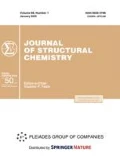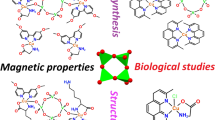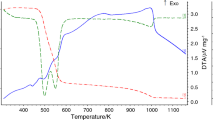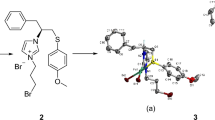Abstract
Binuclear centrosymmetric copper(II) complex of the formula bipyCu(L)4Cubipy, where bipy = 2,2′- bipyridine and L = 4-methoxy-2-phenyl acetate, is synthesized and characterized by FT-IR, UV-Visible, ESR and mass spectroscopy, electrochemical, thermogravimetric, and single crystal XRD techniques. The complex contains two differently oriented molecules per unit cell stabilized via intermolecular interactions. Geometry around each Cu(II) was found to be square pyramidal affected by asymmetrically bridging oxygen atoms occupying the apical position of one square pyramid and the axial position of another in the same binuclear molecule. The square base is formed by two oxygen atoms from two carboxylate ligands and two nitrogen atoms from the bipyridine moiety. TGA shows that the complex is stable up to 170 °C followed by stepwise loss of coordinated ligands, which was supported by GC-MS data as well. A broad absorption spectrum indicated 2B1g as the ground state and single electron occupancy of the dx2–y2 orbital, which was confirmed by the ESR spectrum. The electrochemical study gives two oxidation curves corresponding to Cu(II)/Cu(III) and Cu(I)/Cu(II) and a reduction signal corresponding to the Cu(II)/Cu(I) process. The robust complex represents an interesting contribution to the understanding of coordination chemistry.
Similar content being viewed by others
References
R. P. Sharma, A. Saini, J. Kumar, et al. Inorg. Chim. Acta, 2017, 457, 59–68.
I. Matulkova, J. Cihelka, K. Fejfarova, et al. CrystEngComm, 2011, 13, 4131–4138.
J. P. Collman, R. A. Decreau, Y. Yan, et al. J. Am. Chem. Soc., 2007, 129, 5794/5795.
A. W. Addison, T. N. Rao, J. Reedijk, J. van Rijn, and G. C. Verschoor. J. Chem. Soc., Dalton Trans., 1984, 1349–1356.
B. K. Tripuramallu, S. Mukherjee, S. K. Das, et al. Cryst. Growth Des., 2012, 12, 79–97.
N. Wannarit, C. Pakawatchai, I. Mutikainen, et al. Phys. Chem. Chem. Phys., 2013, 15, 1966–1975.
F. Xu, T. Tao, K. Zhang, et al. Dalton Trans., 2013, 42, 3631–3645.
M. R. P. Kurup, B. Varghese, M. Sithambaresan, et al. Polyhedron, 2011, 30, 70–78.
O. Castillo, A. Luque, S. Iglisias, et al. Inorg. Chem. Commun., 2001, 4, 640–642.
P. Phuengphai, S. Youngme, N. Chaichit, et al. Polyhedron, 2006, 25, 2198–2206.
S. Majumder, M. Fleck, C. R. Lucas, et al. J. Mol. Struct., 2012, 1020, 127–133.
G. S. Baghel, J. P. Chinta, A. Kaiba, et al. Cryst. Growth Des., 2012, 12, 91–96.
C. H. Ng, K. C. Kong, S. T. Von, et al. Dalton Trans., 2008, 4, 447–454.
V. Rajendiran, R. Karthik, M. Palaniandavar, et al. Inorg. Chem., 2007, 46, 8208–8221.
S. Leconte, R. Ruzziconi, et al. J. Fluorine Chem., 2002, 117, 167–172.
A. Hangan, A. Bodoki, L. Oprean, et al. Polyhedron, 2010, 29, 1305–1313.
M. Iqbal, S. Ali, Z.-U. Rehman, et al. J. Coord. Chem., 2014, 67, 1731–1745.
W. W. Sun, S. R. Li, H. Zhou, et al. Z. Anorg. Allg. Chem., 2010, 636, 1386–1391.
M. A. Halcrow, L. M. L. Chia, X. Liu, et al. J. Chem. Soc., Dalton Trans., 1999, 1753–1762.
S. Naskar, S. Naskar, H. Mayer-Figge, et al. Polyhedron, 2012, 35, 77–86.
I. Banerjee, P. N. Samanta, K. K. Das, et al. Dalton Trans., 2013, 42, 1879–1892.
C. Diaz, J. Ribas, M. S. El Fallah, et al. Inorg. Chim. Acta, 2001, 312, 1–6.
M. Mroueh, C. Daher, E. Hariri, et al. Chem. Biol. Interact., 2015, 231, 53–60.
M. M. Ghoneim, A. Z. El-Sonbati, A. A. El-Bindary, et al. Spectrochim. Acta Mol. Biomol. Spectrosc., 2015, 140, 111–131.
Author information
Authors and Affiliations
Corresponding author
Additional information
Original Russian Text © 2018 M. Iqbal, S. Ali, M. N. Tahir.
The text was submitted by the authors in English. Zhurnal Strukturnoi Khimii, Vol. 59, No. 7, pp. 1678–1681, September-October, 2018.
Electronic supplementary material
10947_2018_1040_MOESM1_ESM.pdf
SUPPLEMENTARY MATERIALS TO: ASYMMETRIC OXYGEN BRIDGED COPPER(II) CARBOXYLATE: SYNTHESIS, COMPLETE CHARACTERIZATION, AND CRYSTAL STRUCTURE
Rights and permissions
About this article
Cite this article
Iqbal, M., Ali, S. & Tahir, M.N. Asymmetric Oxygen Bridged Copper(II) Carboxylate: Synthesis, Complete Characterization, and Crystal Structure. J Struct Chem 59, 1619–1623 (2018). https://doi.org/10.1134/S0022476618070132
Received:
Published:
Issue Date:
DOI: https://doi.org/10.1134/S0022476618070132




